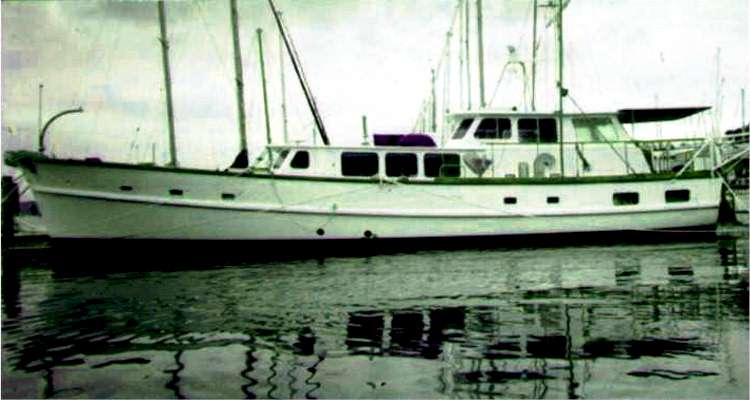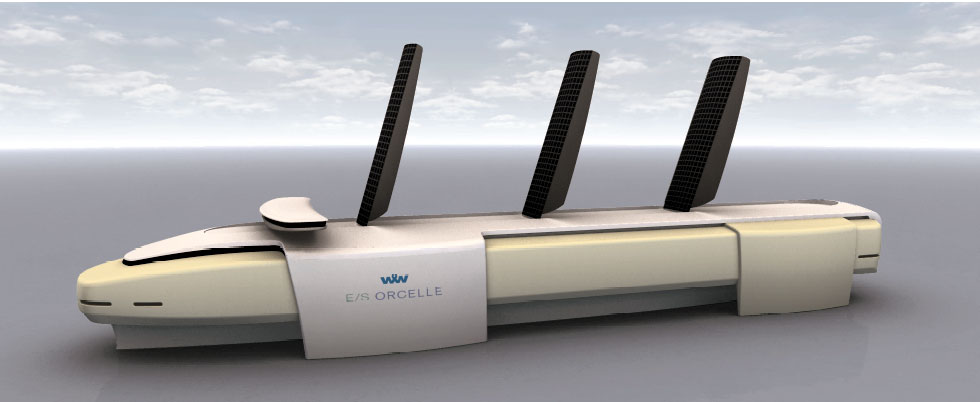Water, Water Everywhere
Dry Dock?You can swim all day in the Sea of Knowledge and still come out completely dry. Most people do. - Norman Juster One of the biggest problems we encountered owning Lady Fair is, because of our size, the fact that there was nowhere in all of Wellington Harbour for us to get hauled out of the water and our bottom washed, scraped, and painted and our through-hulls cleaned and checked. We had to go to Picton or to Christchurch or even up to Auckland for that. Any discovery or invention which reduced the number of times we had to take the boat out of the water (which averaged about every two years) would be something we and every other boat owner would welcome. Any reader who is inspired by Jones' "perfect dryness" idea, please call me once your product is successfully developed. We'd love to help you test it!
Perfect Drynessby David Jones Daedalus once devised a mist-proof plastic for lenses, windows, and so on. He charred its surface with a laser and treated it with fluorine, converting it to graphite fluoride, the most water-repellent substance known. Water drops simply could not adhere. He now plans to extend the idea to wood, leather and similar organics. Such materials are porous. Water does not merely condense on them; it penetrates, and acts as a medium for biological decay. But how to char their vast internal porosity with a few monolayers of graphite? Strong sulphuric acid is notorious for charring organic materials. It abstracts the elements of water from their molecules, leaving carbon. Sulphur trioxide, says Daedalus, is in effect dehydrated sulphuric acid. It should extract hydrogen and oxygen from organics even more avidly. Being easily volatile, it could permeate into the most porous material. Dilution with inert gas could limit its charring action to a few monolayers of surface. Diluted fluorine would then convert the graphite to its fluoride. All internal porosities, however complex, would be perfectly waterproofed. DREADCO chemists are now trying it. They are exposing oars, pairs of boots, plywood shingles, woollen socks, carpets and similar objects to sequences of vapours in a large pressure-vessel. When the process has been perfected, these products will emerge utterly waterproof. Even under high pressure, water will not wet them, let alone enter their pores. But like lesser "breathable" waterproof fabrics (some of which are also based on fluorocarbon polymers), they will still be freely permeable to air and water vapour. This elegant process will transform many technologies. The British building industry is dominated by fear of wood-rot. The first waterproofed, unpainted wooden buildings, flaunting their appealing natural grain against the now impotent weather, will arouse amazement and disbelief. So will truly waterproof boots, fabrics that need no washing (and indeed cannot be washed - water, like dirt, simply falls off them), and wooden boats that slip unwetted through the water. Daedalus even hopes to waterproof human skin. A waterproof swimmer would break all Olympic records. The slow renewal of the skin would gradually remove the coating. The Further Inventions of Daedalus (Oxford University Press), 148 past Daedalus columns expanded and illustrated, is now on sale. Special Nature offer: m.curtis@nature.com Source: Nature 3 February 2000
TBT-Free AntifoulingA vessel's hull must be protected against becoming covered with molluscs and other such organisms, which can form a layer that impairs the water-resistance of the hull and increases fuel consumption and thereby CO2 emissions. Wallenius Marine’s goal is to use antifouling without biocides in order not to affect species in the marine environment. Since 2000 our fleet has been TBT free and we have today two vessels sailing with biocide free antifouling. We are constantly trying out new types of antifouling to find the most suitable type for our kind of vessels and with as low environmental impact as possible. Since 2001, Wallenius Marine supports Swedish biotechnique company Ekomarine AB, which has developed a patented technique to remove marine fouling in a non-toxic way. The technique reconstructs a natural phenomenon that has proven to have an efficient antifouling effect. By creating a biological oxygen demand (BOD) the patented technique creates a thin layer of water with low oxygen level (<10%) above the treated area. The absence of oxygen prevents the settling from hard bodied fouling - mussels, barnacles et cetera. The oxygen level remains undisturbed outside the "reach" of the technique - apptoximately 1.5mm. See ekomarine.se Source: walleniusmarine.com
The Shipwormby Nigel Bunce and Jim Hunt The shipworm is a shellfish which, like the mussel, lives in a shell which opens up into two similar parts. Such a creature is known as a bivalve. The shipworm lives in sea water and attaches itself to the wood of wooden-hulled boats and ships, where it causes damage by boring into the wood. An unusual feature of this mollusk is that it apparently lives on a diet of wood alone, and the question therefore arises as to where it gets the nitrogenous substances necessary for life, because wood is almost entirely composed of compounds of carbon, hydrogen, and oxygen. A principal chemical substance in wood is cellulose, which is the material which makes up the structurally rigid cell walls of plants. Animals such as ourselves are unable to digest cellulose; those animals such as sheep and cows (ruminants) which use cellulose as a foodstuff play host to bacteria which live in the rumen and actually break down the cellulose for the host. Bacteria have the necessary enzymes to break down cellulose; higher animals do not. The second question is thus, "Where does the shipworm get the enzymes needed to digest wood?" These related questions have been answered in an article by John B Waterbury, C Bradford Calloway, and Ruth D Turner, published in Science magazine. T he answer is to be found in a special gland possessed by the shipworm; the gland is called the gland of Deshayes after the person who first described it. Ducts lead from this gland into the digestive tract. What Waterbury and his colleagues have discovered is that the glands of Deshayes is home to a bacterium which produces the enzyme able to degrade cellulose. In exchange, the bacterium gets free room and board. The bacterium in question has never previously been isolated and identified. Waterbury and his colleagues were unable to culture it from sea water. It apparently lives in the shipworm's special gland, and in contrast to the rumen bacteria of sheep and cows, which are of great variety, the gland of Deshayes seems to contain only the one kind of bacterium. The new bacterium will grow outside the shipworm in the laboratory in a solution containing sea water, provided that a carbon source is present. It is obligately marine, meaning that it cannot survive in fresh water and requires sea water. It has the further unusual property that it is able to "fix" nitrogen. This means that the organism can take the nitrogen of the atmosphere, dissolved in sea water, and convert it into compounds from which proteins, et cetera, can be made. This is similar to the ability of the nitrogen-fixing bacteria that live in association with the roots of leguminous plants, such as beans, peas, clover, and alfalfa. It thus seems that the new bacterium provides its host, the shipworm, with the two benefits that allow it to survive in its unusual habitat. It produces the enzymes that are able to break down cellulose, and it also fixes nitrogen into a form that organisms can use. Most organisms, ourselves included, cannot utilise the nitrogen of the air, even though there is so much of it. Quoting the last paragraph of the paper by Waterbury and his associates: "The bacterium from the gland of Deshayes possesses two properties, cellulose digestion and nitrogen fixation, that genetic engineers have been trying (unsuccessfully) to combine in a single bacterium. The combination of these properties in this bacterium makes it a candidate for producing single cell protein from cellulose without the necessity of adding combined nitrogen." In other words, such a bacterium, if it could be cultured on a large scale, could produce usable protein from waste agricultural materials without the need for any expensive chemical inputs, just the nitrogen of the air. No doubt this is a microorganism about which we shall be hearing again. College of Physical Science Source: physics.uoguelph.ca The Science Corner
Nature Powers Ship of the Future
E/S Orcelle A groundbreaking ship designed to run exclusively on renewable energy was unveiled in the Nordic Pavilion at the World Expo 2005 in Aichi, Japan. The E/S Orcelle, a concept cargo ship designed by the Scandinavian shipping company, Wallenius Wilhelmsen, represents a radical vision of the future of ocean transport. It is being hailed as the world's first truly environmentally friendly freight ship. The E/S Orcelle harnesses the power of the sun, wind and water and emits zero emissions into the environment. The ship's revolutionary design incorporates a cargo deck area equivalent to 14 football fields. It has the capacity to carry up 10,000 cars in emission free conditions across the world's oceans. Three giant rigid sails covered in solar panels and 12 dolphin-like fins on the ship's pentamaran hull will help drive it along at a cruising speed of 15 knots. Nils P Dyvik, Chief Executive, Wallenius Wilhelmsen said: "The future is here in our vision of the environmentally friendly ship. While futuristic in its concept we believe that E/S Orcelle represents the achievable goal of building a zero emission cargo ship. We are determined to be at the forefront of efforts, with World Wildlife Fund, to help protect and preserve marine life on the High Seas." Wallenius Wilhelmsen is a global specialist in ocean, inland and outbound supply chain solutions. It is jointly owned by Wallenius Lines of Sweden and Wilh. Wilhelmsen of Norway. The company has around 60 modern vessels, carries 1.7 million vehicles by sea and 1.5 million by road. For further information:
Source: 2wglobal.com 16 May 2005 See also:
For articles on bacteria, centrioles, chairs, nebulae, asteroids, robots, memory, chirality, pain, fractals, DNA, geology, strange facts, extra dimensions, spare parts,
discoveries, ageing and more click the "Up" button below to take you to the Table of Contents for this Science section. |
 Animals
Animals Animation
Animation Art of Playing Cards
Art of Playing Cards Drugs
Drugs Education
Education Environment
Environment Flying
Flying History
History Humour
Humour Immigration
Immigration Info/Tech
Info/Tech Intellectual/Entertaining
Intellectual/Entertaining Lifestyles
Lifestyles Men
Men Money/Politics/Law
Money/Politics/Law New Jersey
New Jersey Odds and Oddities
Odds and Oddities Older & Under
Older & Under Photography
Photography Prisons
Prisons Relationships
Relationships Science
Science Social/Cultural
Social/Cultural Terrorism
Terrorism Wellington
Wellington Working
Working Zero Return Investment
Zero Return Investment
